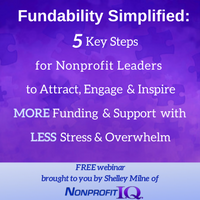Myth #1 – Nonprofits cannot be profitable!
First, let’s be clear on what a nonprofit is and what it is not. The terms nonprofit, non-profit, and not for profit are often used interchangeably to describe a business model that is fundamentally based on societal benefit. Generally speaking, nonprofits emphasize social value, as opposed to their for-profit business counterparts which typically place emphasis on financial gain for the owners or shareholders.
According to the IRS, there are actually 25 or so classifications of nonprofits that are exempt from federal taxes in the U.S., each with different purposes and/or business structures. When people use the term nonprofit, however, most often they’re referring to public charitable nonprofits with a 501(c)(3) tax classification which enables donors to write off their donations. In order to retain its status as a charity, 501(c)(3) nonprofits must demonstrate that ⅓ of their revenue comes from the general public, government or foundation. Incidentally, private foundations also fall under the 501(c)(3) tax classification and are subject to strict rules about how they distribute funds, although donors receive less tax benefits than they do when donating to charitable nonprofits.
Slaying the Myth

Interestingly, the nonprofit industry is the only field that I’m aware of that is named after what it is not, rather than what it is. The name of the industry itself seems to lend itself to the mistaken idea that these business entities cannot be profitable. This is a false belief. In actuality, nonprofits can indeed make a profit, but the profits must be used to further the corporation’s organizational purpose.
The term nonprofit seems to have been conceived out of a value judgement that profit is far less important than addressing important societal challenges. I’m not here to argue whether that value judgement is true or not because everyone has their own opinions and values which are not mine to either approve or reject. I’d also suggest that this insidious, pervasive belief that nonprofits cannot or should not be profitable is slowly eroding our organizations and the industry as a whole. I believe that this is evidenced by the fact that so many of our nonprofits are financially insolvent and cannot even meet their current financial obligations, let alone even fathom the idea of planning for growth and sustainability. Stan Madden who is the Director of the Center for Nonprofit Studies at the Hankamer School of Business at Baylor University claims that only ⅓ of nonprofits survive beyond 5 years.“ There is growing momentum throughout the charitable nonprofit sector about rebranding because there is growing belief that term “nonprofit” is counterproductive to progress and financial stability.
Here’s a very important point that has somehow been largely abandoned in the collective consciousness of nonprofit industry: not only CAN nonprofits make a profit, they SHOULD make a profit! I cannot speak for other countries, but in the U.S., there are no rules against 501(c)(3) charitable nonprofits making a profit. According to the IRS, nonprofit corporations simply cannot divide profits amongst owners, shareholders or board members.
Charities are in fact permitted to charge fees for services. In fact, those nonprofits that are most successful and sustainable often utilize a social enterprise model for revenue generation in addition to the more traditional fundraising methods. Those nonprofits that employ commercial strategies to generate revenue and are not entirely dependent upon donations are often healthier financially and those organizations that are healthier are also more attractive to funders.
A Shocking Realization
Now, let’s take it a step further. Some of you may be shocked to hear that nonprofits DON’T HAVE TO wallow in the constant turmoil and uncertainty about where their funding will come from. While it is a very common misperception that nonprofits are somehow doomed to this never-ending cycle of chasing the funding, it is absolutely not true and this belief is detrimental to your ability to be successful long-term.
While they are in the minority, there are many nonprofits that have a perfectly sound and replicable revenue models that support their operations and allows for growth as needed. Most organizations, however, operate from a very cash-poor position. Think about this. If your organization is focused intently on the fear of where your funding is coming from, how to pay your staff and/or your bills, or how to keep your current program(s) afloat, you don’t have the mental bandwidth to create solutions and strategies to address these issues. When we operate from a fear-based stance, we are so focused on putting out fires, that it’s highly unlikely that we find the time and energy to create a workable plan that utilizes all of the organizations’ strengths resources to work toward creating true financial health and sustainability.
 Operating from a fear-based perspective is counter-productive to your goals. It actually helps create the very circumstances that you DON’T want. This idea is not some new-age hype. It’s science. When you’re under stress, the part of your brain responsible for creativity and problem-solving shuts down. Energetically, you magnetically attract the very conditions that you focus on. This is a whole discussion in itself and if you missed the blog entitled, “How to Attract the Right People & Support to Achieve Your Nonprofit’s Goals”, it goes deeper into the science and philosophy that supports this assertion. I’d like to propose to you that your organizational mindset is the golden key to creating financial health.
Operating from a fear-based perspective is counter-productive to your goals. It actually helps create the very circumstances that you DON’T want. This idea is not some new-age hype. It’s science. When you’re under stress, the part of your brain responsible for creativity and problem-solving shuts down. Energetically, you magnetically attract the very conditions that you focus on. This is a whole discussion in itself and if you missed the blog entitled, “How to Attract the Right People & Support to Achieve Your Nonprofit’s Goals”, it goes deeper into the science and philosophy that supports this assertion. I’d like to propose to you that your organizational mindset is the golden key to creating financial health.
Put Your Knowledge to Action
Now that we’ve debunked the myth that nonprofits cannot be profitable, what can you do to put this knowledge to use?
- Assess the mindset and organizational culture of your nonprofit – Is your organization focused on being proactive and empowering the organization to move toward its goals or does it operate in a, and get stuck in a continuous rut of reacting to problems and never moving forward? If you’re not entirely sure, look at your results. These are your biggest clue.
- Choose – If your organizational culture operates from a fear-based or otherwise negative mindset, make a decision to shift this collective organizational mindset to one that is more empowering; one that will help you create what you want (as opposed to avoiding what you don’t want). This is a subtle, yet extremely powerful distinction.
- Have a heart-to-heart conversation with your board and staff – How can you inspire their interest and buy-in to work together, shift this perspective and create a plan to move you forward utilizing the strengths and interests of your team members?
- Make a plan – Involve all interested staff and board members in implementing it. Make sure you’re checking in on progress and holding each other accountable. Recognize and celebrate progress.
Want More?
 Whether your nonprofit is struggling to survive or you just want to be able to serve your community more effectively and at a level to meet their need, Nonprofit I.Q. can help. If you haven’t already signed up to receive Nonprofit I.Q.’s Hot Freebies, we have some great free tools and resources to get you started.
Whether your nonprofit is struggling to survive or you just want to be able to serve your community more effectively and at a level to meet their need, Nonprofit I.Q. can help. If you haven’t already signed up to receive Nonprofit I.Q.’s Hot Freebies, we have some great free tools and resources to get you started.
When you sign up, you’ll also be added to our mailing list so you’ll be amongst the very first to receive information on our new trainings, tools and resources designed to help your nonprofit become more efficient, effective, and fundable… and to position your organization for ongoing success and sustainability.



